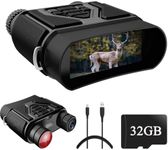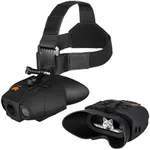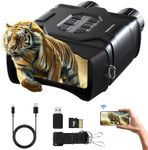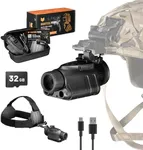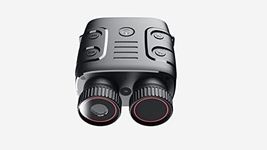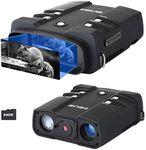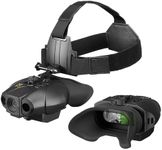Buying Guide for the Best Night Vision Goggle
When choosing night-vision goggles, it's important to understand the technology and features that will best suit your needs. Night-vision goggles amplify available light to help you see in the dark, making them useful for a variety of activities such as wildlife observation, security, or nighttime navigation. Consider what you will primarily use the goggles for, as this will guide you in selecting the right specifications. Understanding the key features will help you make an informed decision and ensure you get the most out of your purchase.GenerationThe generation of night-vision goggles refers to the technology used in the image intensifier tube. This is important because it affects the clarity, range, and overall performance of the goggles. Generations range from 1 to 4, with higher generations offering better performance. Gen 1 is the most basic and affordable, suitable for casual use. Gen 2 offers improved resolution and is good for more serious applications. Gen 3 provides excellent performance and is often used by professionals. Gen 4 offers the best performance but is typically more expensive and used in specialized fields. Choose a generation based on how clear and far you need to see in the dark.
ResolutionResolution in night-vision goggles refers to the clarity of the image you see. It's measured in line pairs per millimeter (lp/mm). Higher resolution means a clearer and more detailed image. Low resolution (below 30 lp/mm) might be sufficient for basic navigation or casual observation. Medium resolution (30-50 lp/mm) is better for more detailed viewing, such as wildlife observation. High resolution (above 50 lp/mm) is ideal for professional use where detail is crucial. Consider what level of detail you need to see in the dark to choose the right resolution.
Field of ViewThe field of view (FOV) is the width of the area you can see through the goggles, usually measured in degrees. A wider FOV allows you to see more of your surroundings without moving your head, which is important for situational awareness. A narrow FOV (below 30 degrees) might be suitable for focused tasks. A medium FOV (30-40 degrees) is good for general use. A wide FOV (above 40 degrees) is ideal for activities where you need to be aware of your surroundings, like navigation or security. Consider how much of your environment you need to see at once to determine the right FOV.
RangeThe range of night-vision goggles is the distance at which you can see clearly in the dark. This is important for determining how far you can observe objects or terrain. Short-range (up to 100 meters) is suitable for indoor use or close-range tasks. Medium-range (100-300 meters) is good for outdoor activities like hiking or wildlife observation. Long-range (over 300 meters) is ideal for surveillance or search and rescue operations. Think about how far you need to see in your specific use case to choose the appropriate range.
Battery LifeBattery life indicates how long the night-vision goggles can operate before needing a recharge or battery replacement. This is crucial for ensuring the goggles last through your activities without interruption. Short battery life (up to 10 hours) might be fine for short outings. Medium battery life (10-20 hours) is suitable for longer excursions. Long battery life (over 20 hours) is ideal for extended use or situations where recharging isn't possible. Consider how long you typically need to use the goggles to select the right battery life.
Weight and ComfortWeight and comfort are important for ensuring that the night-vision goggles are easy to wear for extended periods. Heavier goggles can cause fatigue, while lighter ones are more comfortable. Lightweight goggles (under 1 pound) are ideal for long-term use. Medium weight (1-2 pounds) is manageable for most users. Heavier goggles (over 2 pounds) might be suitable for short-term use or if they offer superior features. Consider how long you will be wearing the goggles and choose a weight that will be comfortable for your needs.
